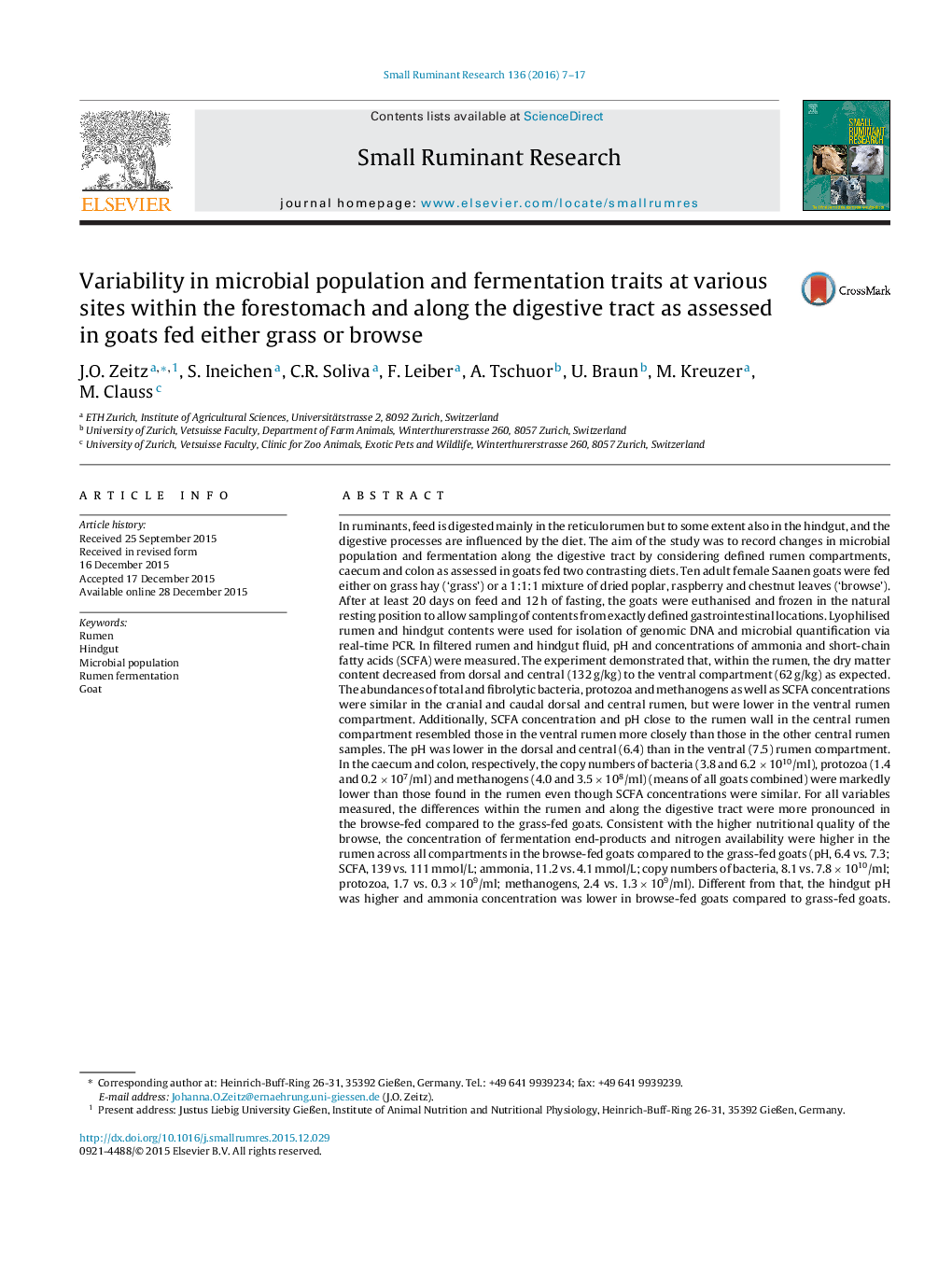| کد مقاله | کد نشریه | سال انتشار | مقاله انگلیسی | نسخه تمام متن |
|---|---|---|---|---|
| 2456686 | 1554356 | 2016 | 11 صفحه PDF | دانلود رایگان |
• We investigated microbiota and fermentation along the digestive tract of goats.
• Goats received either grass hay or dried browse leaves as sole feeds.
• In the rumen of both groups a vertical but no horizontal stratification was found.
• Microbial DNA copies and fermentation end products in hindgut and rumen differed.
• Differences within the rumen and between rumen, caecum and colon depended on diet.
ABSTRACTIn ruminants, feed is digested mainly in the reticulorumen but to some extent also in the hindgut, and the digestive processes are influenced by the diet. The aim of the study was to record changes in microbial population and fermentation along the digestive tract by considering defined rumen compartments, caecum and colon as assessed in goats fed two contrasting diets. Ten adult female Saanen goats were fed either on grass hay (‘grass’) or a 1:1:1 mixture of dried poplar, raspberry and chestnut leaves (‘browse’). After at least 20 days on feed and 12 h of fasting, the goats were euthanised and frozen in the natural resting position to allow sampling of contents from exactly defined gastrointestinal locations. Lyophilised rumen and hindgut contents were used for isolation of genomic DNA and microbial quantification via real-time PCR. In filtered rumen and hindgut fluid, pH and concentrations of ammonia and short-chain fatty acids (SCFA) were measured. The experiment demonstrated that, within the rumen, the dry matter content decreased from dorsal and central (132 g/kg) to the ventral compartment (62 g/kg) as expected. The abundances of total and fibrolytic bacteria, protozoa and methanogens as well as SCFA concentrations were similar in the cranial and caudal dorsal and central rumen, but were lower in the ventral rumen compartment. Additionally, SCFA concentration and pH close to the rumen wall in the central rumen compartment resembled those in the ventral rumen more closely than those in the other central rumen samples. The pH was lower in the dorsal and central (6.4) than in the ventral (7.5) rumen compartment. In the caecum and colon, respectively, the copy numbers of bacteria (3.8 and 6.2 × 1010/ml), protozoa (1.4 and 0.2 × 107/ml) and methanogens (4.0 and 3.5 × 108/ml) (means of all goats combined) were markedly lower than those found in the rumen even though SCFA concentrations were similar. For all variables measured, the differences within the rumen and along the digestive tract were more pronounced in the browse-fed compared to the grass-fed goats. Consistent with the higher nutritional quality of the browse, the concentration of fermentation end-products and nitrogen availability were higher in the rumen across all compartments in the browse-fed goats compared to the grass-fed goats (pH, 6.4 vs. 7.3; SCFA, 139 vs. 111 mmol/L; ammonia, 11.2 vs. 4.1 mmol/L; copy numbers of bacteria, 8.1 vs. 7.8 × 1010/ml; protozoa, 1.7 vs. 0.3 × 109/ml; methanogens, 2.4 vs. 1.3 × 109/ml). Different from that, the hindgut pH was higher and ammonia concentration was lower in browse-fed goats compared to grass-fed goats. The results demonstrated that, when collecting rumen digesta to study the microbial population and rumen fermentation, it is important to distinguish between dorsal/central and ventral rumen sampling points and to consider forage type and quality. However, it is not decisive to distinguish between caudal and cranial rumen regions, provided the sampling is not done in rumen wall proximity and not in close proximity to the oesophagus.
Journal: Small Ruminant Research - Volume 136, March 2016, Pages 7–17
